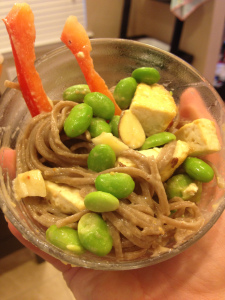This recipe comes originally from the Serve Yourself Cookbook, but saying this is an adaptation of Joe Yonan’s original is like saying my parents named me after an actress who had a guest appearance on Family Ties: that’s technically true, but really more of a jumping off point than anything else.
I probably eat this so often it’s a food group unto itself, and it doesn’t really have a name, so we call it “the soba noodle thing.” It’s super tasty, and if it takes you more than 10 minutes to make, you’re doing it wrong.
Here’s what you’re going to need:
1 package of soba noodles (see note below)
1 package of shelled edamame
1 red bell pepper
6 tablespoons of toasted slivered almonds
1 block of very well-drained, extra extra firm tofu, chopped into smallish pieces
2 tablespoons coconut oil
3 scallions
3 tablespoons natural peanut butter or almond butter
3 cloves garlic, minced
3 teaspoons rice wine vinegar
salt and red pepper to taste
Soba noodles, for your reference, are a buckwheat noodle common in Japan. You can almost always get them at a grocery store, but they’re kinda hidden. They come in these little noodle twist ties, and a pack is usually four of these twist-ties.
Set a pot of water on to boil, and set a skillet on medium-high. Toss the tofu into the oil and let it get to frying. Should take about four or five minutes on each side. Pull it off when it looks like this:
While that’s frying, make your sauce. Combine peanut butter, garlic, vinegar, salt, and red pepper in a bowl. Mix it together a little, and turn the tap to your sink on HOT.
Run the sauce bowl under the hot water a couple times, and mix up. You’re only adding just enough hot water to thin out your peanut butter. Lay it aside.
Sliver your pepper and your scallions.
While you’re doing that, put the noodles in the water. They only get cooked for about 3 minutes. At minute 2, put the edamame in. Strain all of it in your colander. While it is draining out, put the tofu, scallions, almonds, and peppers into the pot.
Return the noodles and edamame to the pot, then pour the sauce on top. Combine to serve.
Fun fact: this is very good hot, but also excellent cold the next day.
